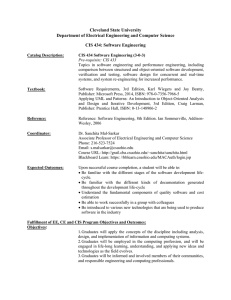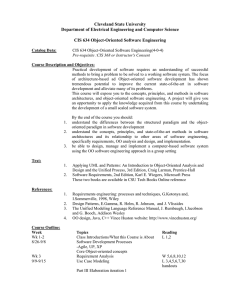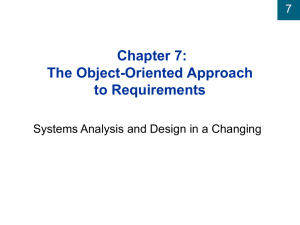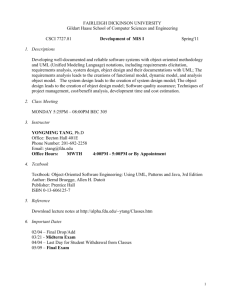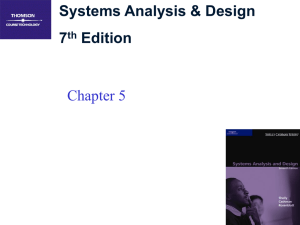Cleveland State University Department of Electrical and Computer Engineering
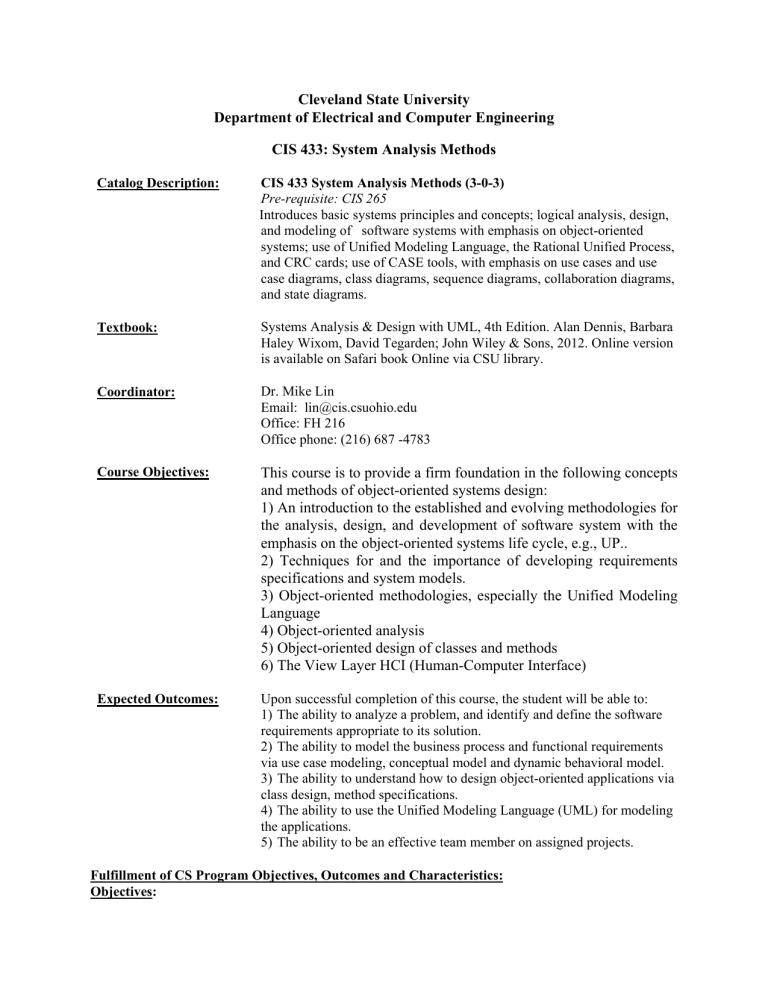
Cleveland State University
Department of Electrical and Computer Engineering
CIS 433: System Analysis Methods
Catalog Description: CIS 433 System Analysis Methods (3-0-3)
Textbook:
Coordinator:
Course Objectives:
Expected Outcomes:
Pre-requisite: CIS 265
Introduces basic systems principles and concepts; logical analysis, design, and modeling of software systems with emphasis on object-oriented systems; use of Unified Modeling Language, the Rational Unified Process, and CRC cards; use of CASE tools, with emphasis on use cases and use case diagrams, class diagrams, sequence diagrams, collaboration diagrams, and state diagrams.
Systems Analysis & Design with UML, 4th Edition. Alan Dennis, Barbara
Haley Wixom, David Tegarden; John Wiley & Sons, 2012. Online version is available on Safari book Online via CSU library.
Dr. Mike Lin
Email: lin@cis.csuohio.edu
Office: FH 216
Office phone: (216) 687 -4783
This course is to provide a firm foundation in the following concepts and methods of object-oriented systems design:
1) An introduction to the established and evolving methodologies for the analysis, design, and development of software system with the emphasis on the object-oriented systems life cycle, e.g., UP..
2) Techniques for and the importance of developing requirements specifications and system models.
3) Object-oriented methodologies, especially the Unified Modeling
Language
4) Object-oriented analysis
5) Object-oriented design of classes and methods
6) The View Layer HCI (Human-Computer Interface)
Upon successful completion of this course, the student will be able to:
1) The ability to analyze a problem, and identify and define the software requirements appropriate to its solution.
2) The ability to model the business process and functional requirements via use case modeling, conceptual model and dynamic behavioral model.
3) The ability to understand how to design object-oriented applications via class design, method specifications.
4) The ability to use the Unified Modeling Language (UML) for modeling the applications.
5) The ability to be an effective team member on assigned projects.
Fulfillment of CS Program Objectives, Outcomes and Characteristics:
Objectives:
1. Graduates will apply the concepts of the discipline including analysis, design, and implementation of information and computing systems.
2. Graduates of will be employed in the computing profession, and will be engaged in life-long learning, understanding, and applying new ideas and technologies as the field evolves.
3. Graduates will be informed and involved members of their communities, and responsible engineering and computing professionals.
Outcomes:
1) An ability to apply knowledge of computing and mathematics appropriate to the program’s student outcomes and to the discipline
2) An ability to analyze a problem, and identify and define the computing requirements appropriate to its solution
3) An ability to function effectively on teams to accomplish a common goal
4) An ability to communicate effectively with a range of audiences
5) An ability to translate fundamental computing concepts to a variety of emerging technologies
Characteristics:
(a) An ability to apply knowledge of computing and mathematics appropriate to the program’s student outcomes and to the discipline
(b) An ability to analyze a problem, and identify and define the computing requirements appropriate to its solution
(c) An ability to design, implement, and evaluate a computer-based system, process, component, or program to meet desired needs
(d) An ability to function effectively on teams to accomplish a common goal
(f) An ability to communicate effectively with a range of audiences
(g) An ability to analyze the local and global impact of computing on individuals, organizations, and society
(i) An ability to use current techniques, skills, and tools necessary for computing practice.
Prerequisites by Topic: CIS 265 Data Structure and Algorithms or Consent of Instructor
Topics:
3 1.
Introduction to Systems Analysis & Design
2.
Forming Project team , Project management
3.
Requirements Determination. Introduction to OO concepts with UML
4.
Business Process Functional Modeling
5.
Structural Modeling
3
6
6
6
6.
Behavioral Modeling
7.
Moving on to design
8.
Class and Method Design
6
3
3
Computer Usage:
9.
Human-Computer Interaction Layer Design
10.
Student Project Presentations
11.
Final Exam
Total
Java, Visio, UML
3
3
3
45



